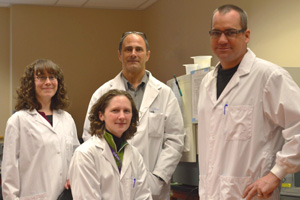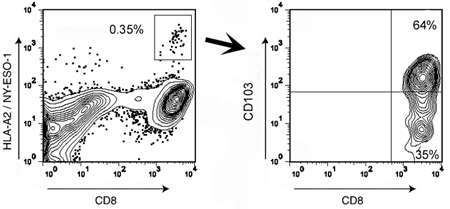Your basket is currently empty!
ProImmune-Pro5
ProImmune’s Pro5® MHC Pentamers are used to investigate immunotherapy prospects for high-grade ovarian cancer
 |
Webb, JR. et al. (2010). Profound elevation of CD8+ T cells expressing the intraepithelial lymphocyte marker CD103 (αE/β7 Integrin) in high-grade serous ovarian cancer. Gynecological Oncology. 118(3): 228-36. [PubMed ID 20541243]
Some of the authors – from left to right: Julie Nielsen, Katy Milne, John Webb, Darin Wick. |
Tumor-infiltrating CD8+ T cells are strongly associated with increased progression-free survival in high-grade serious epithelial ovarian cancer (EOC). Characterizing these T cells is an essential first step in the design of an effective immunotherapy for the disease.
With this in mind, Dr. John Webb and his colleagues at the British Columbia Cancer Agency in Vancouver, Canada, analyzed the infiltrating T cells in tumour ascites from 13 high-grade EOC patients. They were particularly interested in monitoring the cell-surface expression of the integrin CD103, as its expression has previously been found on T cells infiltrating various epithelial tumors. They used a tumor epitope-specific Pro5® MHC Class I Pentamer as part of their work, which provides the first description of CD103+ T cells in any ovarian cancer.
The team found a range of CD103 expression on CD8+ lymphocytes (CTL) from tumor ascites: some patient samples had CD103 expression on fewer than 10% of their CTL, while others had over 70% CD103+ CTL.
In the samples tested, CD103 levels did not correlate with expression of its ligand E cadherin in the tumor microenvironment, but a significant correlation between levels of the cytokine TGFb and CD103 expression on CTL was apparent. This confirmed previous work demonstrating that CTL will up-regulate CD103 in response to the presence of TGFb.
Next, the phenotype of the tumor-infiltrating CD103-expressing CTL was analyzed, as other studies have shown that CD103 expression is required for their anti-tumor activity. The cells carry a surface marker expression pattern consistent with being antigen-experienced, conforming to an effector-memory phenotype. Notably, CD103+ CTL constitutively produced IL-10, suggesting they may act in an immuno-regulatory capacity.
|
|
|
Figure 1. CD8+ T cells specific for the tumor antigen NY-ESO-1 are predominantly CD103+. Flow cytometry analysis of T cells derived from the malignant ascites of an HLA-A2+ EOC patient (IROC013) who demonstrated reactivity to an HLA-A2-restricted epitope of NY-ESO-1. The analysis shows the frequency of CD8+ lymphocytes staining positive with an A*02:01/SLLMWITQV (NY-ESO-1157–165) Pro5 Pentamer. Pentamer-positive CD8+ T cells were further characterized for CD103 expression (right panel). All events were first gated on total lymphocyte populations by forward and side scatter. |
The CD103+ CTL that Webb et al describe in this study appear to be naturally arising, tumor-specific lymphocytes. Further work on these cells in ovarian cancer, and on characterization of similar infiltrating lymphocytes in other tumour types, will be invaluable for development of adoptive immunotherapy. ProImmune Pro5 Pentamers were crucial for this work as they made the highly refined analysis of epitope-specific T cells possible.
This work was carried out in the Deeley Research Centre at the British Columbia Cancer Research Centre www.bccrc.ca/dept/drc

